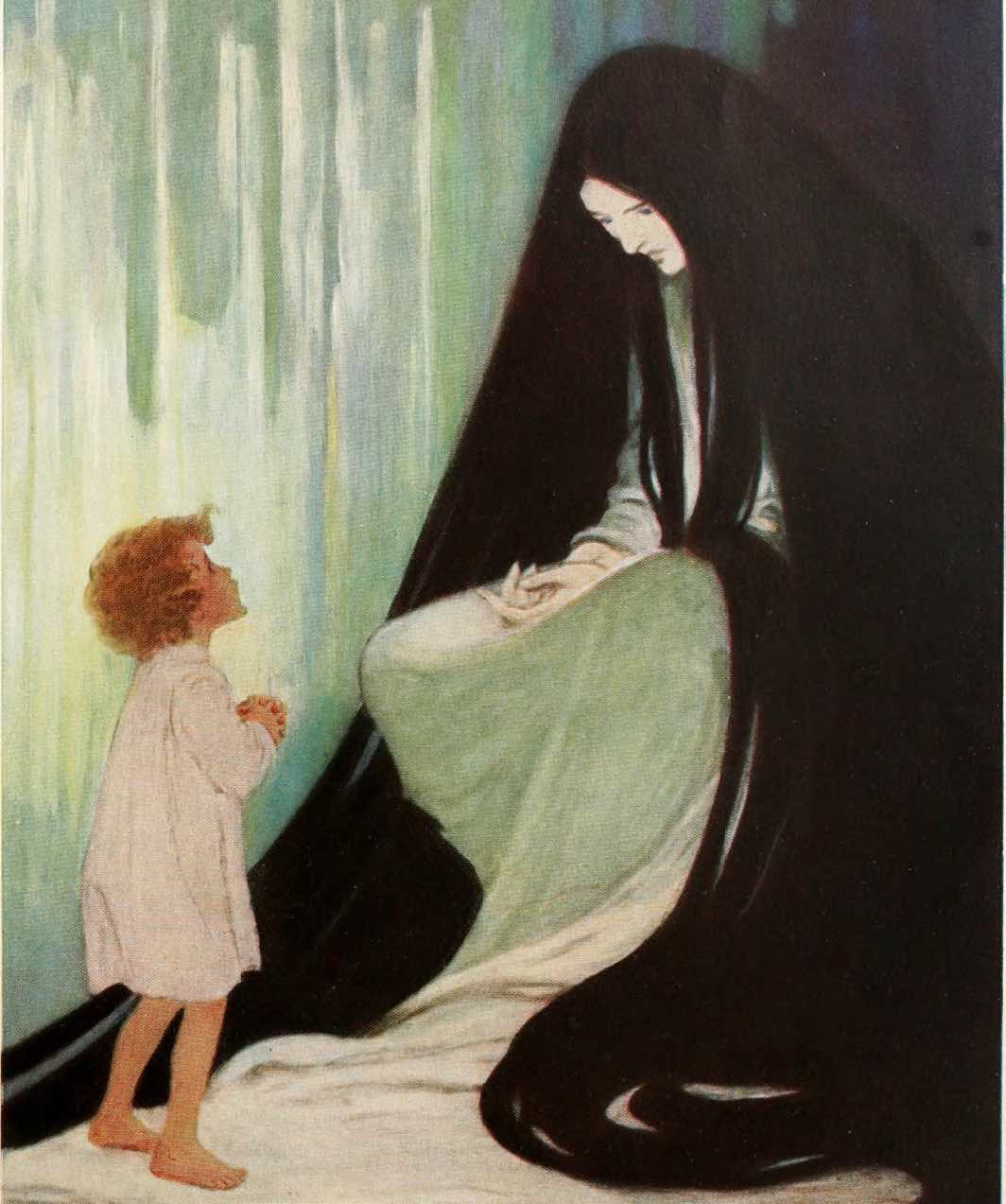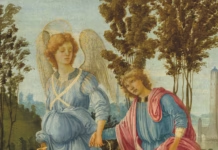At the Back of the North Wind (1919), illustrated by Jessie Willcox Smith
Wikimedia Commons
There is an image that has stayed with me since childhood: a tall woman, almost impossibly tall, taller than the tops of the London houses, with a pale face and masses of black hair that float around her, flying through the night sky underneath a cloud-wreathed moon. Somewhere in her masses of black hair is a child, secure in a nest of hair she has woven for him, holding on to the dark strands as though they were reins. He is a little boy named Diamond, but I often wished it could be me, traveling through the night in the North Wind’s tresses.
I don’t know how old I was when I read At the Back of the North Wind by George MacDonald. Maybe nine or ten? I do know that it captivated me, so much that I read as many other books by him as I could find, although there were not many in my local library, just The Princess and the Goblin and its sequel, The Princess and Curdie, as well as an illustrated edition of a short story, “The Light Princess.” Later, as an adult, I encountered more of MacDonald’s fairy tales as well as his novel-length fantasies, Phantastes and Lilith. They are all equally enchanting. Part of their enchantment is that they feature prominent female characters, good or evil or somewhere in between. MacDonald was an important influence on both C.S. Lewis and J.R.R. Tolkien, but I think his female characters, which inspired theirs, are more complex and compelling. Perhaps this is because he was so deeply influenced by fairy tales, which often focus on female characters, whether princesses or witches or wicked fairies.
In The Princess and the Goblin, for example, Princess Irene lives in a castle in the mountains, far away from her father the king and his court. One night, she loses her way in its corridors and finds a mysterious room at the top of the castle. In it lives a woman with long white hair who claims to be Irene’s great great grandmother, but she can look any age, from young to old. She lives on the eggs of the white pigeons who nest under the roof, and her room contains a spinning wheel on which she spins a silver thread that only Irene can see. Irene can use that thread to find her way home—from anywhere. The thread becomes important when Irene is captured by goblins and she uses it to lead her miner friend Curdie back to the castle. This magical grandmother also becomes important in The Princess and Curdie, in which Curdie must rescue the king from the machinations of his evil ministers. At the beginning of the book, she gives Curdie one of the most interesting magical powers I’ve heard of: When he shakes the hand of any person, he can tell who that person is inside. For example, a respectable-looking cabinet minister might have the hoof of a donkey or a dog’s paw. What is Irene’s great great grandmother? A fairy? A witch? A goddess? MacDonald never tells us, but his fantastical tales are filled with such powerful women.
MacDonald was born in 1824 in Aberdeen, Scotland. His father was a farmer, and he retained a love of the natural landscape throughout his life, as well as a distaste for the factories that were taking over the countryside. Unfortunately, his mother died of tuberculosis when George was only eight years old. The disease, then called consumption, would haunt his family history. His wife Louisa and four of his eleven children would die of it. MacDonald himself suffered from lung troubles and repeatedly tried moving to warmer, healthier climates. He began his career by completing degrees in chemistry and natural philosophy at the University of Aberdeen, then went on to a theological seminary with the intent of becoming a minister. In his very first position, at a Congregationalist church in a small, rural Scottish town, he got into trouble for preaching a doctrine of God’s universal love, by which everyone would eventually be redeemed. After his salary was cut for “heresy,” he resigned and never worked regularly as a minister again. Instead, he became at various points a university professor, traveling lecturer, magazine editor, and popular writer.
These were not particularly lucrative professions. For a while, MacDonald and his growing family were desperately poor, but the success of Phantastes and subsequent novels brought fame and financial stability. He befriended some of the most famous writers and thinkers of his day, including John Ruskin and Lewis Carroll, who was a particular family friend. After completing an initial draft of what would eventually become Alice in Wonderland, Carroll brought it over to MacDonald to see what he thought. Louisa read it to their children, and their enthusiasm convinced Carroll to publish what would become his most famous book. In Through the Looking-Glass, the White Queen’s daughter is named after MacDonald’s oldest daughter Lily, who would eventually die of tuberculosis—a devastating loss for her father.
To escape the English climate, which was considered particularly bad for diseases of the lung, the MacDonalds moved to the village of Bordighera in Liguria, Italy, where George and Louisa lived for twenty years. Their house, called Casa Coraggio, became a social center and literary salon for the local English community. The MacDonalds would host concerts, theatricals, and poetry readings. Louisa died the year after their fiftieth anniversary and was buried in the English cemetery at Bordighera. George returned to England and died three years later. His ashes were sent to Italy to rest with his beloved wife.
During his lifetime, MacDonald wrote more than fifty books, including popular novels about life in Scotland as well as collections of essays, sermons, and poetry. However, the literature that lives on is the fairy tales. In addition to the fantastical novels I loved as a child, MacDonald also wrote a number of shorter tales. In “The Light Princess,” the fairy Makemnoit is not invited to the princess’s christening, and of course there are consequences: The princess is cursed with the loss of gravity (both physical and emotional). She floats like a balloon, and she is incapable of feeling sad or even serious. She is eventually brought back down to earth by the selfless love of a prince. When the prince shows that he is willing to give his life for her, she realizes the gravity of the situation—and becomes once again subject to the laws of physics.
Later tales are darker and more serious, particularly one of MacDonald’s most famous, “The Golden Key.” In it, the boy Mossy finds a golden key and wonders what it opens. He is sent on a quest through Fairyland with the girl Tangle, and the two go through various adventures, both together and apart, looking for a mysterious country whose inhabitants cast shadows on our earth. The tale is not an allegory—it’s not at all clear what this country is or what Mossy and Tangle will find when they get there. But like all of MacDonald’s best stories, it gives us the sense that there is a reality beyond the one we see with our ordinary eyes. If we believe, we can see the extraordinary, like Princess Irene’s great great grandmother’s silver thread or the majestic North Wind.
Two of my favorite tales are “Little Daylight” and “The History of Photogen and Nycteris,” which are related by the motifs of night and day. “Little Daylight,” an earlier tale, is gentler and more suitable for children. In it, Princess Daylight is, of course, cursed at her christening. Evil fairies run rampant in MacDonald’s stories, and you never know when one might be living near you, probably in a cottage in the wood. This particular evil fairy curses Daylight to wake only at night, and additionally to wax and wane with the moon. The curse is broken only when a prince shows her care and affection during her waning phase, when she is not her usual beautiful self. All of MacDonald’s fairy tales stress the importance of compassion—in his fantastical world, it is the highest virtue. “Little Daylight” is actually told by a storyteller in At the Back of the North Wind, and MacDonald often includes stories within stories. The “History of Photogen and Nycteris” is a rare stand-alone story originally published in a popular magazine, and it’s not really for children. In it, the witch Watho takes two children, a girl and a boy, and raises them in opposite circumstances. The boy, Photogen, is only allowed to see daylight. He is taught to be strong and fierce, a hunter and warrior. The girl, Nycteris, is only allowed to see darkness. She lives in a secluded part of the castle lit by a single dim lamp hanging from the ceiling. Of course, Watho’s plans go awry—Nycteris finds her way out of her solitary room and into the larger world. She feels the burning light of day, while Photogen experiences the darkness of night, which terrifies him. It is only when they encounter each other and find strength in the other’s weakness that they can foil Watho’s terrible plan. In MacDonald’s fairy tales, the happy ending often involves finding what we lack and becoming whole.
Before J.R.R. Tolkien wrote “On Fairy-stories,” his famous essay about fairy tales, MacDonald wrote an essay called “The Fantastic Imagination” in which he anticipated much of Tolkien’s perspective. He argued that writers could invent their own fairy worlds, but those worlds must have their laws, just as ours does, or readers would not believe in them. Tolkien would expand on this idea with his theory of “subcreation,” in which the writer creates a secondary world that feels as real as the primary world we live in. MacDonald stated that fairy tales have their own meaning but that meaning might be different for every reader. A fairy tale is not an allegory—it does not “represent” anything. “A fairy tale, like a butterfly or a bee, helps itself on all sides, sips at every wholesome flower, and spoils not one,” he wrote. “The true fairy tale is, to my mind, very like a sonata.” The point of a fairy tale is to wake things in the reader, so that the reader feels or thinks something new and beautiful. In this way, a fairy tale is like nature itself: “Nature is mood-engendering, thought-provoking: such ought the sonata, such ought the fairy tale to be.” MacDonald also claimed that fairy tales were not just for children; he himself wrote his stories “for the childlike, whether of five, or fifty, or seventy-five.”
So if you are five, or fifty, or seventy-five, or any age old and young enough to appreciate a fairy tale, I highly recommend that you read the magical writings of George MacDonald. If it’s winter, start with At the Back of the North Wind so you can curl up by a warm fire or radiator and appreciate the cold chill of that great lady with the long black hair. If it’s summer, start with The Princess and the Goblin so you can wander in the dark underground mountain passages with Irene and Curdie for a while, then return to sunlight and birdsong. Afterward, if you like MacDonald, and I think you will, keep following the silver thread of his fairy tales from story to novel to fantastical essay, like the thread of Irene’s mysterious great great grandmother, which always leads us home.



































